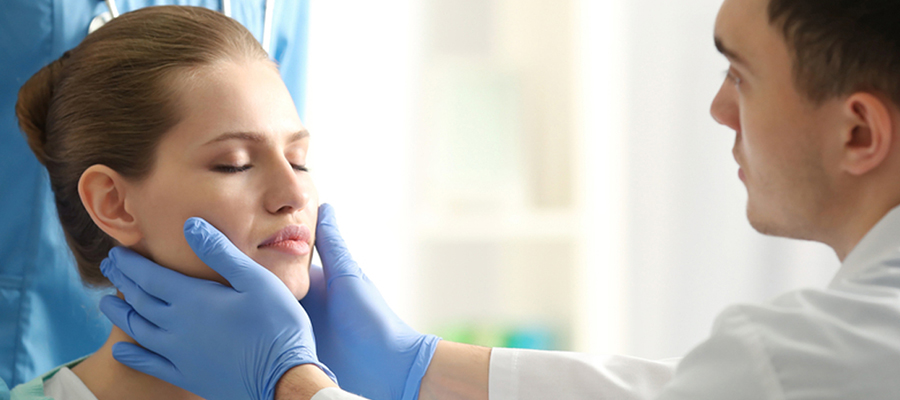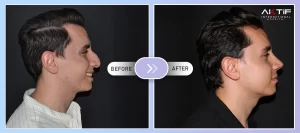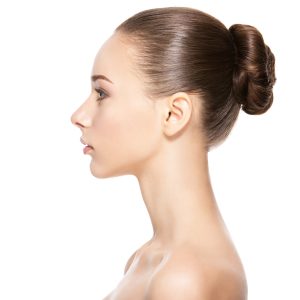
Estimated reading time: 6 minutes and 37 seconds
Revision Rhinoplasty
What You Need to Know Before Considering This Procedure
If you have undergone rhinoplasty in the past and are unhappy with the results, revision rhinoplasty may be an option to correct the issues that arose from the initial surgery. The surgery is also known as secondary rhinoplasty, or corrective rhinoplasty and it is a more complicated procedure than primary rhinoplasty. This article will provide you with the essential information you need to know before considering this operation.
When is this procedure necessary?
Revision rhinoplasty may be necessary if the initial surgery resulted in an unsatisfactory outcome. The procedure can address a range of issues, including asymmetry, breathing problems, visible scarring, and deformities.

Rinoplasti Before – After
Understanding the Basics of Revision Rhinoplasty
How is Revision Rhinoplasty Different from Primary Rhinoplasty?
This surgery is more complicated than primary rhinoplasty because it involves correcting existing surgical changes. In some cases, patients may require multiple revision surgeries to achieve their desired results.
What Can Revision Rhinoplasty Correct?
This surgery can address a range of issues that may have arisen from the initial surgery, such as:
- Breathing problems: If the initial rhinoplasty resulted in breathing difficulties, revision rhinoplasty can address issues such as a deviated septum or collapsed nasal valves.
- Asymmetry: If the nose appears asymmetrical after the initial surgery, this operation can correct the issue.
- Visible scarring: If the initial surgery resulted in visible scarring, this surgery can improve the appearance of the scar tissue.
- Deformities: If the initial surgery resulted in nasal deformities, corrective rhinoplasty can address issues such as a twisted or crooked nose.
How Long Does It Take?
The length of the surgery can vary depending on the extent of the revision needed. On average, secondary rhinoplasty takes between two and four hours.
Choosing the Right Surgeon
Why is Choosing the Right Surgeon Important?
Choosing the right surgeon is critical when considering revision rhinoplasty. The procedure is more complicated than primary rhinoplasty, and it requires an experienced and skilled surgeon.
What Qualities Should I Look for in a Surgeon for the Operation?
When choosing a surgeon for revision rhinoplasty, look for the following qualities:
- Experience: The surgeon should have experience in performing corrective rhinoplasty procedures.
- Credentials: The surgeon should be board-certified and have the appropriate credentials.
- Before-and-after photos: Look at the surgeon’s before-and-after photos to see their work and assess their skill level.
- Patient reviews: Read patient reviews to get an idea of the surgeon’s bedside manner and overall patient satisfaction.
Risks and Recovery Process
What are the Risks?
As with any surgery, there are risks associated with revision rhinoplasty. These risks can include:
- Infection
- Bleeding
- Scarring
- Numbness or loss of sensation
- Breathing problems
- Need for additional surgeries
How Long is the Recovery Process?
The recovery process for revision rhinoplasty is similar to that of primary rhinoplasty. Patients can expect swelling and bruising around the nose and eyes for several weeks. Patients should also avoid strenuous activities and heavy lifting for several weeks following the surgery.

Revision Rhinoplasty
Cost and Insurance Coverage
How Much Does It Cost?
The cost of the surgery varies depending on the extent of the revision needed and the surgeon’s experience. On average, revision rhinoplasty costs between $8,000 and $15,000.
Will Insurance Cover the Surgery?
In most cases, insurance does not cover revision rhinoplasty because it is considered a cosmetic procedure. However, if the revision is necessary to correct breathing problems or other medical issues, insurance may cover the procedure.
Frequently Asked Questions
Is the operation more painful than primary rhinoplasty?
The level of pain experienced during revision rhinoplasty is similar to that of primary rhinoplasty. Patients can expect some discomfort and pain, but this can be managed with pain medication prescribed by the surgeon.
How long does the swelling last after the surgery?
The swelling after the surgery can last for several weeks, and it can take several months to see the final results. However, patients should see a significant improvement in the appearance of the nose within the first few weeks after the surgery.
Can revision rhinoplasty correct botched nose jobs?
Yes, revision rhinoplasty can correct botched nose jobs. However, the success of the procedure depends on the extent of the damage done during the initial surgery and the skill of the surgeon performing the secondary rhinoplasty.
What should I expect during the surgery consultation?
During the consultation, the surgeon will examine the patient’s nose and discuss the patient’s goals for the secondary rhinoplasty. The surgeon will also review the patient’s medical history and provide a detailed explanation of the procedure, risks, and recovery process.
How long after the initial surgery can I undergo revision rhinoplasty?
Patients should wait at least one year after the initial surgery before undergoing revision rhinoplasty. This allows the nose to fully heal and gives the surgeon a better idea of the changes needed to achieve the desired results.
When can I see the final results of the operation?
The final results of secondary rhinoplasty can take several months to become fully apparent. The nose will continue to heal and change over the course of a year, with the most significant changes occurring in the first few months after the surgery. However, patients should see a significant improvement in the appearance of the nose within the first few weeks after the surgery.
What are the risks of the operation?
As with any surgery, secondary rhinoplasty carries risks such as bleeding, infection, scarring, and anesthesia complications. There is also a risk of poor healing, which may require further revisional surgery.
How long does the recovery process take after the surgery?
The recovery process after revision rhinoplasty can take several weeks. Most patients can return to work or school within two weeks, but it may take several months to see the final results of the surgery.
Will revision rhinoplasty leave visible scars?
The surgeon will make incisions inside the nose or in inconspicuous areas to minimize visible scarring. However, there may be some visible scarring, particularly if the surgeon needs to make significant changes to the nose.
Can the surgery be covered by insurance?
Revision rhinoplasty may be covered by insurance if it is deemed medically necessary. This may include cases where the initial surgery resulted in breathing problems or other functional issues. However, insurance coverage varies depending on the patient’s specific situation and insurance plan.
In conclusion, revision rhinoplasty is a complex procedure that requires the expertise and skill of a highly trained surgeon. It is an option for patients who are unhappy with the results of their initial rhinoplasty and wish to improve the appearance or function of their nose. While the recovery process may take several weeks and there are potential risks and complications involved, the benefits of revision rhinoplasty can be life-changing for some patients. If you are considering revision rhinoplasty, it is important to consult with a board-certified plastic surgeon who has experience in performing the procedure. Aktif International can help you achieve the nose you’ve always wanted.
Author: Burak Dikmen
For more information about this surgery, please visit the websites of our doctors listed below:
Burak Dikmen – Revision Rhinoplasty


 TR
TR